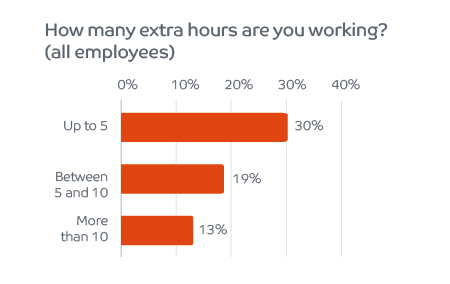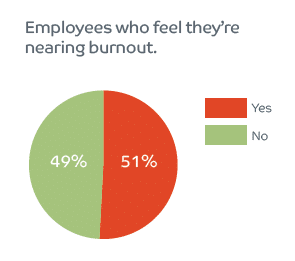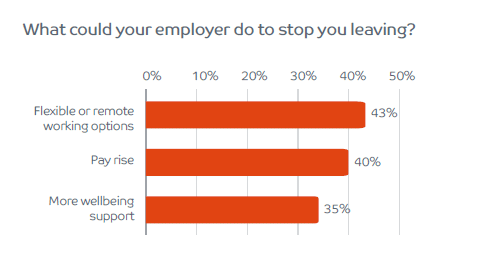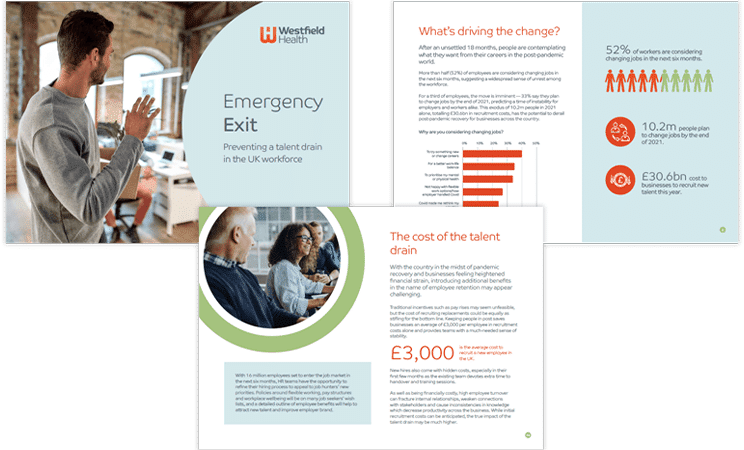Pandemic pressures are driving people to change jobs, but what would make them stay?
The past 18 months have caused many people to rethink their priorities, and now 16m workers are considering voting with their feet. For UK businesses, this exodus could total up to £48.2bn in recruitment costs and prolong economic uncertainty for employees and business leaders alike.
Our latest report, Emergency Exit, explores the results of a 1,500-person survey into the pandemic’s effects on mental health, burnout and career change. So what factors are driving people to seek a career change, and how can employers convince them to stay?
Longer hours are taking their toll
While the pandemic has seen our ways of working transformed, many employees have struggled to prioritise their mental health. Adapting to a new work environment is draining in itself, but people have been working even longer hours, adding further strain to this difficult situation.

Almost two thirds (62%) of employees have been working more hours during the pandemic, averaging an extra 3.75 hours per week. This equates to roughly half a working day on top of a normal working week, or 8.7bn hours since the start of the pandemic. This disruption of work-life balance has a significant mental health impact on the workforce, but employees — particularly remote workers — may be struggling in silence as they strive to appear motivated and engaged.
Of those working longer hours, over a fifth (21%) are working more than 10 extra hours per week, adding a full working day to their schedule. Employers may initially perceive these extra hours as increased productivity, but unsustainable working practices are beginning to impact employee wellbeing and drive people to seek a better work-life balance elsewhere.
Employees are approaching mass burnout
After 18 months of longer hours, reduced social contact and continued disruption, over half the workforce (51%) say they’re less than a month away from burnout.

With employees in survival mode, the strain will impact not only individuals but the workforce as a whole. And as over a quarter (28%) of employees feel they’re at risk of burnout within a week, mass exhaustion is an imminent threat for managers and HR teams.
Those working from home are the most likely to be feeling overwhelmed: 34% say burnout is less than a week away. Their lack of physical presence in the workplace may be leading them to overcompensate by sacrificing their work-life balance. Of those working from home, 70% say they’ve been working longer hours and over a fifth (21%) are taking shorter breaks.
Easing the pressure to improve retention
While employees are contemplating big changes, the majority (65%) have not yet started actively job seeking, and only 17% say there’s nothing their employer can do to change their mind.
This window of opportunity allows managers and HR teams to start making changes which compel people to stay, but where do employee priorities lie?

Job security and better pay are now more important to 53% of people, and wellbeing support and flexible working are a higher priority for 47%.
With the pandemic making employees less visible to managers and HR teams, their wellbeing issues and lack of job satisfaction are more likely to go unnoticed. An adaptable wellbeing strategy can ensure employees feel heard and provide them with the resources they need to improve their work-life balance and mental health, making them less likely to seek solace by changing jobs.
While new policies are often costly and time-consuming to implement, the business impact of recruiting new talent cannot be understated. Recruitment costs an average of £3,000 per employee, but additional training costs can be a budget drain, especially for smaller companies. New hires may also impact team dynamics and business relationships as they get to grips with new ways of working. This adjustment period can decrease productivity across the business and lower morale, risking a domino effect of resignations.
The full report and free webinar
For a more detailed look at the findings, download our Emergency Exit report. It contains an examination of the research and the underlying reasons for unrest in the workforce, plus tips on how to prevent burnout and increase employee retention.
You can also sign up to our free webinar on Thursday 14 October, where you’ll learn how to create a wellbeing culture that retains and attracts top talent.
